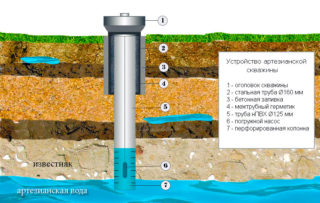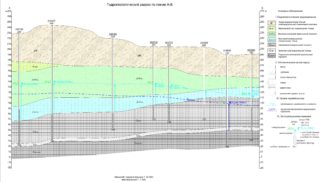In preparation for drilling a well, it is advisable to carry out preliminary exploration work. They help to find out at what distance from the surface of the earth the layers saturated with moisture are located. A map of the occurrence of aquifers in a particular region is useful here. If not, the depth of the formation can be determined by the type of vegetation on top and the type of rocks selected when drilling.
What is an aquifer
All aquifers can be characterized by the following parameters:
- Performance. It is determined in m3 of the resource volume per unit of time.
- The depth of the top and bottom of the horizon (in meters from the surface of the earth).
- The amplitude of the resource fluctuation during the year. Depends on the season, temperature, rainfall, atmospheric pressure.
- Power. The thickness of the soil saturated with water.
The deeper the hydrogeological layer, the more constant its productivity will be.
Types of aquifers
With regard to the depth of the location of aquifers, they are classified according to the deepening / moving away from the surface of the earth;
- Verkhovodka. You can stumble upon it already 5 meters from the top point of drilling. The saturation of this layer occurs exclusively due to atmospheric precipitation. Often in the heat, the water level here seriously decreases, or even disappears altogether. In addition, the liquid from the top water absorbs all the pollution from the soil, atmosphere, nearby industrial enterprises, outlets - everything that is absorbed into the soil with rain or runoff. It is especially dangerous to use a resource from a verkhovodka if there are cemeteries nearby, street toilets with a cesspool, complex chemical, industrial enterprises. It is important to pay attention to the fact that in the northern regions this horizon is often localized in the zone of soil freezing. Therefore, it will be difficult to draw water from here in winter. An additional disadvantage of the liquid from the verkhovodka is the constant presence of oxygen in it. Microorganisms live and multiply in the water.
- Ground water. The seam goes to a depth of about 10 meters. Its main component as a support is clay. It is believed that this aquifer also contains insufficiently pure water, since such a depth is still not enough for its high-quality filtration.
- Interstratal waters. The depth of their location can vary from 15 to 100 m. More often they are located between two watertight horizons. The debit of such layers is stable. But it is important to take into account that the water that has reached the interstratal veins can be oversaturated with minerals, metal salts, which it absorbs along the entire path of its downward movement. Therefore, liquid from these horizons requires careful analysis and a properly selected filtration system.
- Artesian waters. They are located at a depth of 100 m or more. The water here is as pure as possible, having passed many degrees of natural filtration.According to the law of the Russian Federation "On Subsoil", artesian wells are under special control of the state. Therefore, a license is required for drilling and further exploitation of such a source.
It is better to drill an artesian well for several families or households, since its flow rate seriously exceeds the needs of even 3-5 people.
Aquifers map
Each map contains information about the types of groundwater, schemes and their depth. Also included here are the designations of aquicludes and all soil layers, the direction of free flows.
The most popular hydrogeological maps:
- Hydroisogypsum. Created for gravity reservoirs. It shows the system of movement of streams in aquifers. With the help of such schemes, it is possible to understand what the slope and direction of the water is, where the reservoir is fed or unloaded, where it joins with natural reservoirs.
- Hydroisopyez. They are performed according to the available accurate data. The piezometric surface is taken out for artesian sources. It means the height to which the water in the opened well is able to rise. According to this indicator, the total length of the casing string is selected.
- Groundwater (ground) water level measurement map.
- Documentation on hydrogeological sections.
- Amplitude maps of liquid levels in sources.
Such schemes and documents can be found in the local archives of the settlement. If new, previously unpopulated territories are being developed, new hydrogeological maps are drawn up for them.
How to determine the water level while drilling
- cattail is located where there is a perch with a depth of 1-1.5 m;
- reeds like places with an underground layer at a level of 1-3 meters, black poplar prefers to be located here;
- sarsazan favors zones with a groundwater level of up to 5 m;
- wormwood is less whimsical and can grow freely where the layer lies 7 meters from the earth's surface;
- sandy wormwood loves places with the location of aquifers at a level of 9-10 m, it is at this depth that a needle-well is made for irrigation, the use of the resource for technical purposes;
- alfalfa thrives in a 15-meter underground aquifer.
If plants with a powerful root system are located on the site, it means that the level of water resources is located deep. If the plant cultures have small roots, the underground layers are not far from the earth's surface.
You can find out the depth of water for a well by the type of sand selected when drilling. If the grains are large, the layer is removed by more than 8 meters. The finer the grains, the sooner the master will stumble upon the aquifer.
Accurate results from observation alone are not possible. To determine the depth of the hydrogeological point as correctly as possible, it is advisable to contact a specialist.
How to find out the depth of an already drilled well
To determine the level of the location of the aquifer, you can use the following tools:
- Special logging cable equipped with a measuring roller. Its calibration is based on the following principle: 1 meter of depth is equal to one unwinding.
- ICGS depth gauge. With its help, it is possible to recognize the angle and depth of the source due to the echo signal sent and reflected from the bottom of the borehole.
- Roulette hydrogeological RGLM.It can be used to measure up to 50 m depth. If there is no such tape measure, just use a cord with a load (cobblestone or metal element).
When drilling a spring shaft, it is important to distinguish quicksand from a real aquifer. The first has a large amount of clay in the withdrawn water and is difficult to drill.












